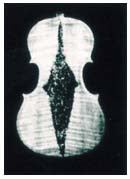So how do skilled violin makers optimize the tone of an instrument during the construction process? They begin by selecting a wood of the highest possible quality for the front and back plates, which they test by tapping with a hammer and judging how well it "rings".
The next important step is to skilfully carve the plates out of the solid wood, taking great care to get the right degree of arching and variations in thickness. The craftsman has to learn how to adjust the plates to produce a fine-sounding instrument. Traditional makers optimize the thickness by testing the "feel" of the plates when they are flexed, and by the sounds produced when the are tapped at different positions with the knuckles. This is the traditional equivalent of nodal analysis, with the violin maker's brain providing the interpretative computing power.
However, in the last 50 years or so, a group of violin makers has emerged who have tried to take a more overtly scientific approach to violin making. The pioneer in this field was Carleen Hutchins, the doyenne of violin acoustics in the US. Now almost 90 years old, but still active in the field, she founded the Catgut Society of America in 1958, together with William Saunders of "Russell-Saunders coupling" fame and John Schelling, a former director of radio research at Bell Labs. The society brings together violin makers and scientists from across the world, with the common aim of advancing our understanding of violin acoustics and developing scientific methods to help makers improve the quality of their instruments.
One common practice that has been adopted by violin makers has been to replace the traditional flexing and tapping of plates by controlled measurements. During the carving process, the thinned plates are suspended horizontally above a large loudspeaker. The acoustic resonances excited by the loudspeaker can readily be identified by sprinkling glitter onto the surface of the plates. When the loudspeaker has excited a resonance, the glitter bounces up and down, and moves towards the nodal lines of the resonant modes excited (figure 7). The aim is to interactively thin or "tune" the first few free-plate resonances to specified frequencies and nodal patterns.
Unfortunately, there are very few examples of such measurements for really fine Italian instruments because their owners are naturally reluctant to allow their violins to be taken apart for the sake of science. The relatively few tests that have been performed suggest that the early Italian makers may have tuned the resonant modes of the individual plates - which they could identify as they tapped them - to exact musical intervals. This would be consistent with the prevailing Renaissance view of "perfection", which was measured in terms of numbers and exact ratios.
Members of the "scientific" school of violin makers might reasonably claim that this could be the lost Stradivarius secret. However, it must indeed have been secret, since there is no historical evidence to support the case. Although many first-class modern violins have been built based on these principles, there is little evidence to suggest that they are any better than many fine instruments made with more traditional methods.
